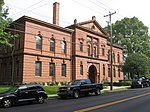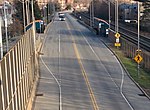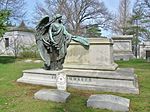The Frick Pittsburgh

The Frick Pittsburgh is a cluster of museums and historical buildings located in Pittsburgh, Pennsylvania, United States and formed around the Frick family's nineteenth-century residence known as "Clayton". It focuses on the interpretation of the life and times of Henry Clay Frick (1849–1919), industrialist and art collector. The complex, located on 5.5 acres (22,000 m2) of lawn and gardens in the city's Point Breeze neighborhood, includes Clayton, the restored Frick mansion; The Frick Art Museum; The Car and Carriage Museum; the Greenhouse; the Frick children's playhouse; and The Café. The site welcomes over 100,000 visitors a year. Admission is free. Helen Clay Frick (1888—1984) was the driving force to preserve the Frick estate and allow it to open to the public after her death.
Excerpt from the Wikipedia article The Frick Pittsburgh (License: CC BY-SA 3.0, Authors, Images).The Frick Pittsburgh
Reynolds Street, Pittsburgh
Geographical coordinates (GPS) Address Phone number Website External links Nearby Places Show on map
Geographical coordinates (GPS)
| Latitude | Longitude |
|---|---|
| N 40.44635 ° | E -79.902512 ° |
Address
The Frick Pittsburgh
Reynolds Street 7227
15208 Pittsburgh
Pennsylvania, United States
Open on Google Maps










